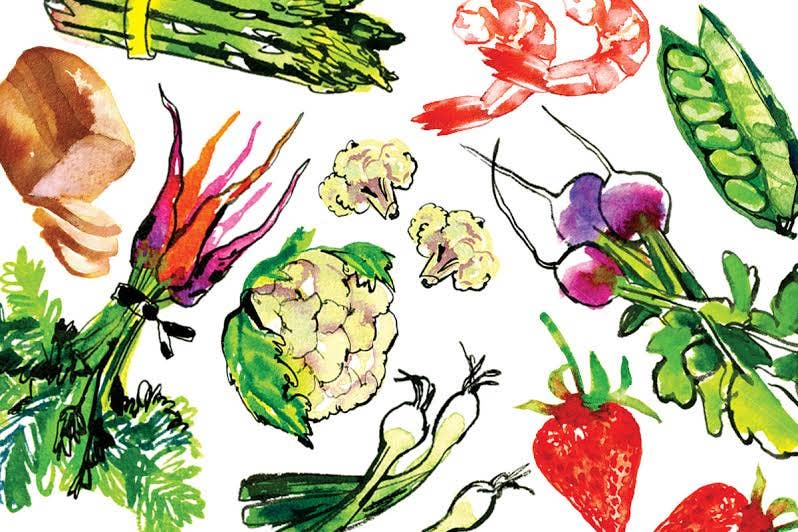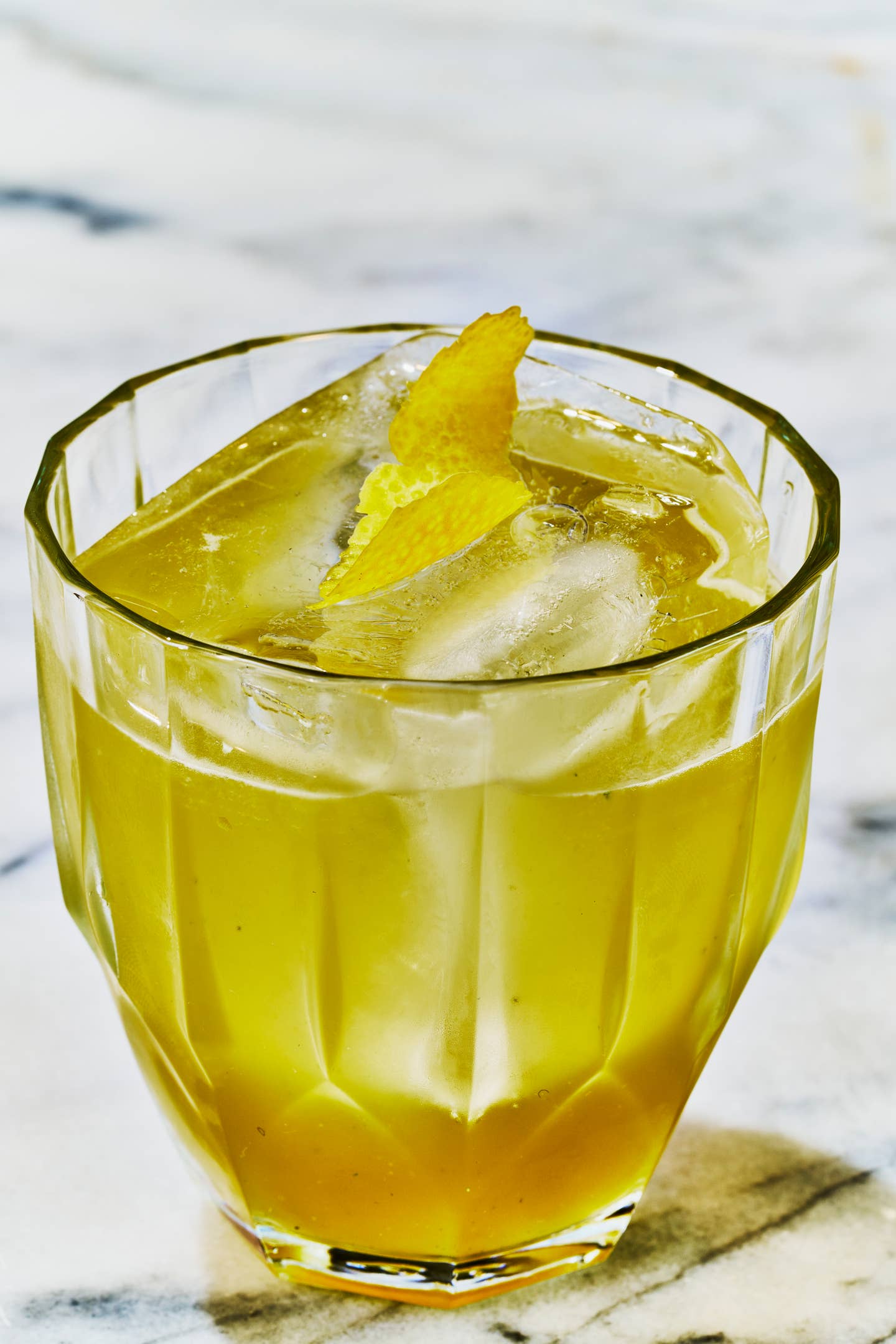
Campbeltown Original
It has been raining, of course. There are puddles on the ground, and a haze of moisture blurs the air. We walk into the distillery courtyard, past a yard full of empty barrels—French oak barriques, old bourbon casks, a few containers labeled Maine Rum—some stacked, some standing upright. Weeds sprout between paving stones. Some of the buildings around us are whitewashed; others are gray-brown brick stained black by smoke and weather and burred with umber moss. There are black iron braces on some walls and jungle-gym tangles of scaffolding and pipes, and an avalanche of charcoal-hued blocks of peat heaped in one corner. The roofs are grooved tin. This is a working factory, not some tourist showplace. The Industrial Revolution doesn't seem very far away.
There are four categories of scotch malt whisky, classified according to geography: Highland, Lowland, Islay, and Campbeltown. The Highlands region is the big show, the area with the most distilleries by far and most of the ones everybody's heard of (The Glenlivet, Glenfiddich, The Macallan, Glenmorangie, and so on). The majority of the other well-known ones come from Islay (pronounced EYE-la), the most important of whisky islands, among them Laphroaig, Bruichladdich, and Bowmore. Lowland whiskies are marginal to the American consumer. And then there's Campbeltown.
Sitting all by itself, a three-and-a-half-hour drive from Glasgow and almost 160 miles from the Highlands capital of Inverness, on the east-facing side of a long prong of land extending into the North Channel, Campbeltown has only three distilleries. And only one of them is currently producing any quantity of whisky: Springbank.
If Campbeltown today seems like a footnote to the story of scotch whisky, it was once a main attraction. This part of Scotland may even have been the birthplace of scotch: almost everybody, even the Scots, believes that the art of making whisky was born in Ireland; no part of Scotland lies closer to the Emerald Isle than Campbeltown's peninsula, and trade (illicit and otherwise) between the two places was common. The earliest written reference to whisky in the region dates from 1591, and Campbeltown became a hotbed of illegal distilling before it developed a legal whisky industry. By 1800, it is said, there were 22 legal distilleries operating within the town itself and another ten in the surrounding area. The Mitchell family opened a distillery called Riechlachan in 1825 and three years later built a second one—Springbank.
Traditional Campbeltown whisky was heavily peated and similar in style to the iodine-scented whiskies of Islay. It was much in demand for blending, and ships headed across the Atlantic stopped at Campbeltown to load on what was—as Peter Currie, Springbank's sales and marketing executive, puts it—"the last whisky before America". Unfortunately, distilleries got greedy and started cutting corners to increase production, ultimately damaging the whisky's reputation. Technological improvements also meant that larger distilleries elsewhere were able to mass-produce comparable whisky on such a scale that they put smaller producers out of business. Campbeltown distilleries closed down one by one, until only two were left: Springbank and one called Glen Scotia.
The unglamorous Glen Scotia distillery, with its flaking paint and boarded-up windows, still exists but has been in and out of mothballs for decades and today operates on a limited basis. (It has three full-time employees; Springbank has 53.) Springbank, meanwhile, is still owned by a descendant of its founders, Hedley Wright, under the banner of J. & A. Mitchell & Co. Ltd.—which also owns a spirits bottlers called Cadenhead's (hence the rum casks in the courtyard) and has recently revived Glengyle, an old distillery next door. "Glengyle is our blank piece of paper," says Peter Currie. "Springbank is tradition, but here we can do whatever we want." The first Glengyle whisky of modern times is scheduled for release in 2014, at the age of ten years.
"Springbank is fiercely independent," says Currie. "We're not members of the Scotch Whisky Association or anything like that. And we're unique because we're the only distillery in Scotland that does absolutely everything itself, on-site, from malting right through bottling." (Only five other producers still do their own malting.)
The malting floor—where barley, the raw material for this kind of whisky, is allowed to sprout, producing the starches that will be converted into fermentable sugar—suggests some strange northern European indoor version of a Zen garden. On two levels of a warehouse-like building with big, open windows, ten or 12 tons of barley is spread out on the concrete to a thickness of about three to nine inches (depending on the season), soaked repeatedly in water, raked repeatedly so that it malts evenly, and given about six days to sprout. It is then dried in massive kilns with peat smoke, hot air, or both. Springbank bottles whiskies in two other styles under two different labels: Longrow is dried with peat smoke only; Hazelburn is unpeated, dried with hot air alone.
From the kilns, the malt is ground and mixed with water from Crosshill Loch, a century-old artificial lake built specially to supply water to local distilleries; yeast is added, and the sugary liquid, or wort, is allowed to ferment for about 70 hours. Springbank ferments in five 25,000-liter tuns of Scandinavian boatskin larch. Next, the fermented liquid, called the wash, is distilled in huge copper stills. Most whisky is double-distilled: the first results are called low wines; the second are feints. Springbank likes to say that its whisky is distilled two and a half times, because a 20/80 mixture of low wines and feints is distilled another time; thus some of the finished whisky has been distilled twice and some three times. After distillation, Springbank, like all malts, is aged in wood. The 92-proof ten-year-old is blended from spirits aged in both old bourbon and old sherry casks; the 100-proof ten-year-old sees nothing but bourbon wood; the 92-proof 15-year-old is aged predominantly in sherry wood.
Springbank's general manager is Frank McHardy, a native of Fife, in southeastern Scotland. "I left school at 15 with no qualifications whatsoever," McHardy tells me, as I taste whisky with him at Springbank, "and worked on a farm for two years. Then my father got a job as personnel manager at the Invergordon distillery, and that's where nepotism comes in. I signed on and was put on what they called the flying squad. We did anything from sweeping floors to rolling casks. Then I graduated into mashing. In 1966, Invergordon opened a new distillery called Tamnavulin, and I moved over there. They were great, these small distilleries, because you did everything. At Tamnavulin I learned all about barrels."
In 1973, McHardy was hired as assistant manager at Bruichladdich, on Islay, where he stayed until 1977, when he was hired by Springbank as distillery manager. In 1986, McHardy was hired away from Springbank by Bushmills, in Northern Ireland. "For some reason," he says with a smile, "it was their policy to hire Scottish distillery managers until they got me. Now they don't do it anymore." In 1996 he returned to Scotland to retire and be near his grandchildren—but Springbank called and lured him back to work as general manager. "I'll be here till I decide to retire again," he says.
As he talks, the whiskies are telling a story of their own. In general, they're light but complex, with a faint saltiness and a whiff of pleasant sugar-cookie perfume from the bourbon casks. The regular ten-year-old seems sweet at first but quickly dries out on the palate; it is well-balanced, with a hint of acidity and just a little smoky peat character. The 100-proof is sharper and slightly gassy, with a mild iodine-and-seaweed aroma that evokes its Islay neighbors, and has an astringent finish. The 15-year-old is almost cognac hued, with a sweet sherry aroma, a fairly oily consistency, and a flavor that variously suggests burnt almonds, Christmas pudding, and mocha. All three whiskies are superb. "Springbank isn't traditional Campbeltown malt," McHardy says. "We're beyond that."
Keep Reading
Continue to Next Story










